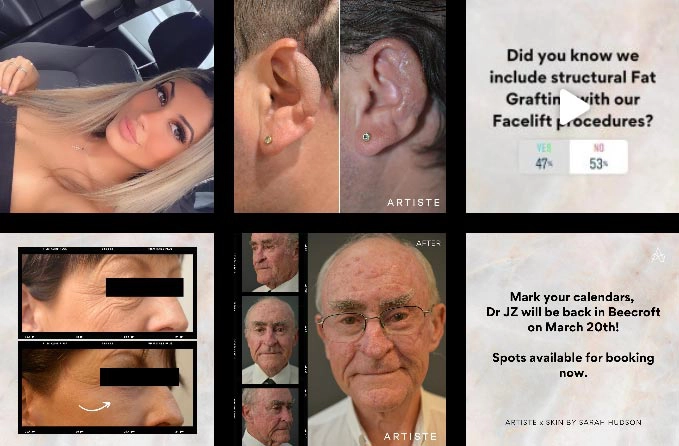Debunking Myths About Blepharoplasty Surgery
Model featured in photography
Blepharoplasty, also known as eyelid surgery, is a surgical procedure intended to address concerns related to the upper or lower eyelids. While it is sometimes considered for cosmetic reasons, it can also assist those whose severe upper eyelid sagging may affect vision.
It is important to understand the facts surrounding this procedure to make an informed decision. This overview seeks to clarify common misconceptions about blepharoplasty.
Myth #2: Blepharoplasty surgery is not a painful and risky procedure
While blepharoplasty is commonly performed, it is essential to recognize that it is an invasive surgical procedure and carries inherent risks. Some people may approach cosmetic surgeries with a casual mindset, but that should not be the case.
Potential risks of blepharoplasty include scarring, tissue irregularities, uneven eyelid contours, ptosis (drooping of the eyelid), and lid retraction. In rare cases, severe complications such as visual disturbances or embolic events can occur. Understanding these risks emphasises the need for thorough consideration and consultation with a qualified healthcare provider to ensure that this procedure aligns with your overall health and expectations.
Myth #3: Blepharoplasty surgery will not leave noticeable scars
There is always a risk of scarring with any surgical procedure and one should not expect any differently from a surgery as invasive as blepharoplasty.
While these incisions are typically placed in the natural creases of the eyelids to make them less visible, the extent of scarring varies from person to person. Factors such as skin type, healing response, and post-operative care play crucial roles in the appearance of scars.
Myth #4: Blepharoplasty surgery is only for cosmetic purposes
Blepharoplasty may be considered for cosmetic or functional reasons. In some cases, excess skin on the upper eyelids can contribute to vision obstruction (ptosis) and a blepharoplasty may be an option.
Myth #5: Results of blepharoplasty surgery are long-lasting
Some may believe that blepharoplasty surgery results are permanent, it’s important to understand that no cosmetic procedure can halt the natural ageing process.
Blepharoplasty can provide noticeable changes, but the longevity of results varies for each individual. Factors such as skin elasticity, lifestyle habits, and genetic predispositions all play a role in how long the benefits may last.
Patients should have realistic expectations and discuss with their surgeon that while improvements can be substantial, maintenance and the effects of ageing should be considered over time.
Conclusion
If you are considering blepharoplasty, consulting with a qualified and experienced plastic surgeon can help assess your individual concerns and discuss potential treatment options. It’s essential to understand the procedure, including what it involves and the expected recovery process, to make an informed decision.
Remember, plastic surgery is a significant decision that should be made with comfort and understanding throughout the process. Always communicate openly with your surgeon, ensuring any concerns or hesitations are addressed before proceeding.
Disclaimer: At Artiste Plastic Surgery, our Plastic Surgeons led by Dr Jack Zoumaras have been trained to the highest possible degree. All surgery has risks and it is always advised to get a second opinion. Risks are very real and we cannot guarantee any result. Results are illustrated as a guide only. All risks are managed and any need for revision surgery or complications (1-5%) can be managed by our specialist plastic surgeons.
Any statements on how you will feel is based on Level V Evidence:
Level V: How you will feel after plastic surgery varies between individuals, depending on psychological and physical factors. Our internal research is based on how patients in our practice feel after surgery.
The blogs are not a substitute for a medical consultation and do not form as part of the doctor to patient relationship.
SHARE THIS ARTICLE
Jul01
Facelift Recovery Tips: What Speeds Up Healing and What to Avoid
Disclaimer: At Artiste Plastic Surgery, our Plastic Surgeons led by Dr Jack Zoumaras have been trained to the highest possible degree. All surgery has risks and it is always advised ...
Jul01
How to Prepare for Facelift Surgery: What to Do Before Your Big Day
Disclaimer: At Artiste Plastic Surgery, our Plastic Surgeons led by Dr Jack Zoumaras have been trained to the highest possible degree. All surgery has risks and it is always advised ...
ABOUT ARTISTE
Artiste Plastic Surgery is an Award Winning Specialist Plastic Surgery practice led by internationally trained Dr. Jack Zoumaras, Plastic Surgeon and Peer Reviewed Face Surgeon
Artiste offers the latest Cosmetic Surgical Procedures of the Face, Breast and Body, inspired from leading centres around the world.
STAY IN THE LOOP
Enter your email address below to receive updates on new articles and VIP access to promotions and special offers.
FOLLOW US ON INSTAGRAM










